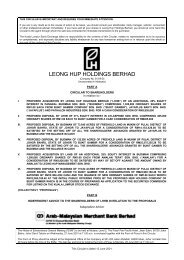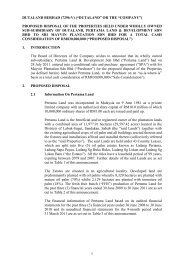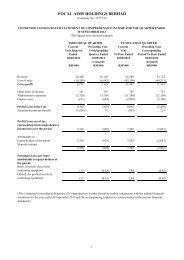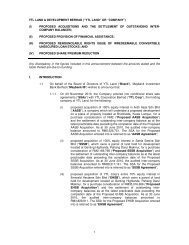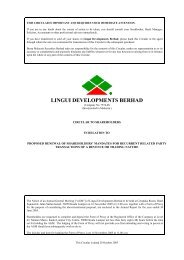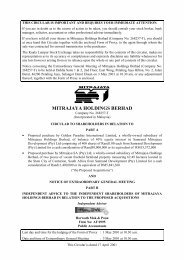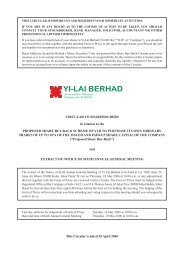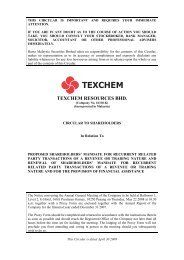MITRA-AnnualReport2011 (1.2MB).pdf - Announcements - Bursa ...
MITRA-AnnualReport2011 (1.2MB).pdf - Announcements - Bursa ...
MITRA-AnnualReport2011 (1.2MB).pdf - Announcements - Bursa ...
Create successful ePaper yourself
Turn your PDF publications into a flip-book with our unique Google optimized e-Paper software.
Notes to The Financial Statements (cont’d)<br />
2. SUMMARy of SIGNIfICANT ACCoUNTING polICIES (CoNT’D)<br />
2.3 Significant Accounting policies (cont’d)<br />
2.3.17 financial liabilities (cont’d)<br />
(ii) Other financial liabilities (cont’d)<br />
For other financial liabilities, gains and losses are recognised in profit or loss when the liabilities are<br />
derecognised, and through the amortisation process.<br />
A financial liability is derecognised when the obligation under the liability is extinguished. When an existing<br />
financial liability is replaced by another from the same lender on substantially different terms, or the<br />
terms of an existing liability are substantially modified, such an exchange or modification is treated as a<br />
derecognition of a new liability, and the difference in the respective carrying amounts is recognised in profit<br />
or loss.<br />
2.3.18 financial Guarantee Contracts<br />
A financial guarantee contract is a contract that requires the issuer to make specified payments to reimburse<br />
the holder for a loss it incurs because of a specified debtor fails to make payment when due.<br />
Financial guarantee contracts are recognised initially as a liability at fair value, net of transaction costs.<br />
Subsequent to initial recognition, financial guarantee contracts are recognised as income in profit or loss<br />
over the period of the guarantee. If the debtor fails to make payment relating to financial guarantee contract<br />
when it is due and the Group as issuer, is required to reimburse the holder for the associated loss, the liability<br />
is measured at the higher of the best estimate of the expenditure required to settle the present obligation at<br />
the end of the reporting period and the amount initially recognised less cumulative amortisation.<br />
2.3.19 leases<br />
Assets acquired by way of hire purchase or finance leases are stated at an amount equal to the lower of<br />
their fair values and the present value of the minimum lease payments at the inception of the leases, less<br />
accumulated depreciation and impairment losses. The corresponding liability is included in the statement<br />
of financial position as borrowings. In calculating the present value of the minimum lease payments, the<br />
discount factor used is the interest rate implicit in the lease, when it is practicable to determine; otherwise,<br />
the Group’s incremental borrowing rate is used. Any initial direct costs are also added to the carrying amount<br />
of such assets.<br />
Lease payments are apportioned between the finance costs and the reduction of the outstanding liability.<br />
Finance costs, which represent the difference between the total leasing commitments and the fair value<br />
of the assets acquired, are recognised as an expense in profit or loss over the term of the relevant lease<br />
so as to produce a constant periodic rate of charge on the remaining balance of the obligations for each<br />
accounting period.<br />
The depreciation policy for leased assets is in accordance with that for depreciable property, plant and<br />
equipment.<br />
2.3.20 provisions for liabilities<br />
Provisions are recognised when the Group has a present obligation as a result of a past event, it is probable<br />
that an outflow of economic resources will be required to settle the obligation and the amount of the<br />
obligation can be estimated reliably.<br />
Provisions are reviewed at the end of each reporting period and adjusted to reflect the current best estimate.<br />
If it is no longer that an outflow of economic resources will be required to settle the obligation, the provision<br />
is reversed. If the effect of the time value of money is material, provisions are discounted using a current<br />
pre-tax rate that reflects, where appropriate, the risks specific to the liability. When discounting is used, the<br />
increase in the provision due to the passage of time is recognised as finance cost.<br />
56 <strong>MITRA</strong>JAYA HOLDINGS BERHAD ANNUAL REPORT 2011




